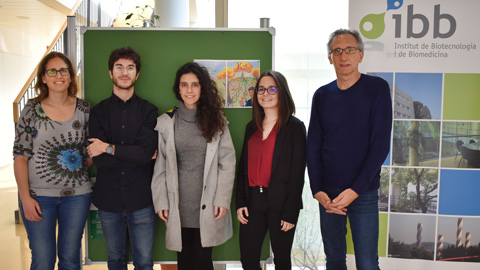Over 800 new genome regions relevant to human evolution identified

04/02/2019
A study by the research group in Bioinformatics of Genome Diversity at the UAB, published in the journal Nucleic Acids Research, increased by 40% the total number of natural selection signals detected in the human genome until now. Researchers were able to add a total of 873 new human genome regions as firm targets of natural selection at some point in time in the human lineage. These will be added to the 1,986 already detected regions, providing a very valuable set of data to help answer the question: What makes us humans?
The large amount of genomic data attained through the genomic revolution has drastically changed the evolutionary vision of our species' past, challenging interpretations and solving disputes upheld for years by archaeologists, historians, anthropologists and linguists. By colonising almost all corners of the planet, our species has found itself subject to continuous adaptation challenges. These selective pressures left their mark on the genome's affected regions which can be inferred by analysing genetic variations.
In 2018, the research group Bioinformatics of Genome Diversity at the Universitat Autònoma de Barcelona (UAB), in collaboration with scientists from the Institute of Evolutionary Biology (IBE), published PopHuman, the greatest inventory of genetic diversity measures computed throughout the human genome thanks to data from the 1000 Genome Project. By using PopHuman, UAB researchers scanned a set of 8 measures, which detect different genome prints from different time scales along the genome. The detection of these regions in the human species permits scientists to evaluate general genomic impact as well as determine specific genomic variants responsible for different human adaptations.
Diagram of the flux used to detect and characterise structurally and functionally the candidate regions under selection in the human genome.
The study includes information from 22 human populations and a total of 2,859 candidate regions under selection. A total of 1986 of these regions had already been detected and studied. The new study by UAB researchers therefore contributes with 40% more genomic signals relevant to human adaptation, some of which are related to the hybridisation of the human species with the Neanderthals and other hominid species. Among the results obtained are well known examples of local adaptations, such as the recurrent adaptations produced in the region containing the LCT gene, which encodes the enzyme responsible for breaking down lactose. Another classical example of local adaptation can be found in the region containing the EGLN1 gene, related to the hypoxia inducible factor (HIF) which is in turn related to the ability to live in high-altitudes, such as those living in Tibet.
Researchers foresee that future studies of new genomic signals detected will help them explain new examples of human adaptation, as well as improve our knowledge on how the introgression of archaic genomes have modelled our current genomes.
The results have been compiled in the new PopHumanScan catalogue. The catalogue was designed as a collective database which for the first time includes numerous structural and functional notes on the regions, as well as the recurrence of selection signals in the different populations analysed. PopHumanScan aspires to become a central repository where studies on natural selection in humans can be shared and help guide future studies which will improve our understanding of how selection has modelled our genome as a response to the changes in the environment or lifestyles of human populations.
Original article:
Jesús Murga-Moreno, Marta Coronado-Zamora, Alejandra Bodelón, Antonio Barbadilla, Sònia Casillas; PopHumanScan: the online catalog of human genome adaptation, Nucleic Acids Research, Volume 47, Issue D1, 8 January 2019, Pages D1080-D1089, https://doi.org/10.1093/nar/gky959 Impact factor: 11,561.
Review of the PopHuman navigator published in UABDivulga
https://www.uab.cat/web/detalle-noticia-1345680342040.html?noticiaid=1345745031404
PopHumanScan Catalogue
PopHumanScan was published in January in the prestigious journal Nucleic Acids Research and can be accessed freely here:
https://pophumanscan.uab.cat.
Detailed guide on how to use the catalogue:
https://pophumanscan.uab.cat/about.php